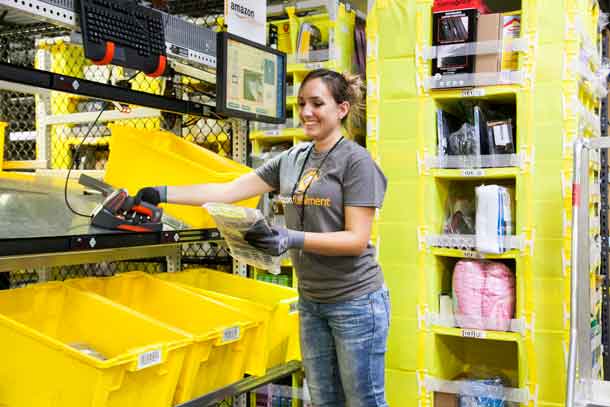By Sylvain Charlebois
Senior Fellow
Atlantic Institute for Market Studies
Amazon Bets Big with Smart Moves
HALIFAX, N.S. – LIVING – Amazon is intent on becoming the world’s most powerful retailer, with the help of food sales.
Amazon’s US$13-billion takeover of Whole Foods isn’t shocking. It’s been rumoured for months. Now the mammoth Amazon, with its large revenues and small profits, has confirmed those rumours by making the biggest deal in its history. And acquiring troubled Whole Foods is more than timely for both companies.
Food retailing was once not much more than a distraction for Amazon: its online grocery business, AmazonFresh, is only available in a handful of cities.
Now, however, food is a key piece of Amazon’s long-term focus. Food is a US$700-billion sector in the U.S. and almost $120 billion in Canada. It’s too much for Amazon to ignore.
Most importantly, selling food is another way for Amazon to attract and retain customers, especially if they’re tied to the Amazon Prime subscription service.
Purchasing Whole Foods is a quick way to build a high-margin business in the food retail industry.
Amazon is known for its low, affordable prices and quick, efficient execution. In contrast, Whole Foods is intimidating to customers seeking affordable prices: it has a strong brand but also high prices. Amazon’s logistics, and extensive automation and technology can make Whole Foods more economically accessible.
More selection, lower prices and delivery accuracy will be the pillars of a successful acquisition. Add the Whole Foods brand, prime locations and established supply chains of high-quality organic products, and Amazon can make Whole Foods work again. Since capacity and reliability are always challenges in organic procurement, Amazon is starting from a strong position.
Amazon is known for being disruptive across varied markets. It provides the world’s largest cloud infrastructure, its television shows have won 11 Emmys in two years, it’s a global leader in tablet sales (behind only Apple and Samsung), its work in artificial intelligence is competitive with Google and IBM, and it operates the world’s most-watched live video streaming service (Twitch). Amazon is a technology company as much as it’s a retailer, and its capacity to drive digital transformation has led to its dominance in e-commerce.
This capacity is evident in its concept for how brick-and-mortar retail stores should work, Amazon Go. The prototype version, in Seattle, allows consumers to enter a store, pick food products and simply leave. Amazon uses in-store sensors, smart phones, data science, and a deep understanding of consumers to track purchases and charge customers’ credit cards. A growing number of consumers aren’t willing to wait in line to give a retailer money.
While most grocers try to figure out what to do with the immense amount of data available to them, Amazon generates even more data and uses it to adapt to a shifting clientele.
Amazon, Walmart and Costco are doing to the grocery sector what Apple did to the music business almost 20 years ago.
The music industry resisted change, even as consumers figured out how to download music for free, illegally. That’s when Apple introduced the revolutionary iPods and the iTunes music store for convenient, legal access to music. Few observers believed people would be willing to pay a dollar per song, but it happened.
Today, more songs are sold each year than ever. But the music industry must share that revenue. Apple dictated a new regime to an old guard in a completely different sector and has reaped the rewards.
The same fate awaits food retailing if it doesn’t embrace the future.
Amazon crippled the bookstore and its next prey could be the food store. Given its ability to fuse efficient distribution and strong strategic market insight, Amazon could well become the leading food retailer in North America.
Amazon still considers Canada a pilot project but that may change quickly. Undoubtedly, the company is serving notice to Canada’s food distribution establishment.
Canadian food companies are still trying to harmonize the bricks and mortar approach with online space. Most are barely in the online game (the average rating of Canadian grocers’ iPhone apps is two out of five). The fact that food sales aren’t the core of Amazon’s business is likely keeping Canadian food retail executives up at night.
Amazon’s size and reach allow it to beat most competitors on price. And since millennials have a long-standing relationship with online shopping, that competitive advantage is key. With a portfolio of new fashionable private labels, millennials are clearly on Amazon’s mind.
Whole Foods is now owned by a company that didn’t exist 25 years ago.
Amazon, which prioritizes growth and evolution over profit, is clearly making a statement.
Sylvain Charlebois is Senior Fellow with the Atlantic Institute for Market Studies, dean of the Faculty of Management and a professor in the Faculty of Agriculture at Dalhousie University, and author of Food Safety, Risk Intelligence and Benchmarking, published by Wiley-Blackwell (2017).
© 2017 Distributed by Troy Media
The views, opinions and positions expressed by all columnists and contributors are the author’s alone. They do not inherently or expressly reflect the views, opinions and/or positions of NetNewsLedger.






